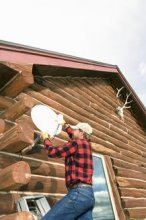Satellite dish splitter
 A splitter divides a satellite singal in two.
A splitter divides a satellite singal in two.
Thinkstock/Comstock/Getty Images
A splitter in the cable from a satellite dish divides the signal into two parts to connect to two receivers. However the signal in each direction loses more than half its power. An additional splitter will cut the signal power in half again. Multiple splitters may reduce the signal to such a low power level that it's unusable.
Satellite Dish Cable
The cable from a satellite dish may work for distances from 100 to 200 feet, depending on the type of cable used, the signal power at the output of the low noise block amplifier (LNB) in the dish and the sensitivity of the receiver. RG6 is the most common cable used, but WF100/PF100 has less loss and should be used for distances over 100 feet. You can't calculate and exact distance without knowing the exact output power of the LNB and the exact sensitivity of the receiver, expressed in decibels (dB).
Splitter Power Loss
A splitter reduces the signal by at least 3.5 dB, which results in two signals with less than half the power of the original. Some splitters have even more loss. In general calculations, a splitter reduces the usable length of the cable by half. But the signal level also loses power as it travels along a cable. If you have a usable signal at 200 feet, a splitter may reduce the signal so low you can't use it on either side. If you put the splitter right at the dish, each receiver must be within 50 to 100 feet.
Multiple Splitters
Assuming a worst case scenario, without a splitter, you can install the receiver at 100 feet from the dish. If you install a splitter 50 feet from the dish, each side can only go an additional 25 feet. With another splitter connected to it, each side can go an additional 12 1/2 feet, and with another roughly six more feet . With a splitter at the dish and another at 25 feet from it, the outputs can only go an additional 12 1/2 feet, making an overall distance of 37 1/2 feet.
Amplifiers
In-line satellite amplifiers increase the power of the signal in the cable from the dish to the receiver, and come in models with various amounts of gain expressed in dB. An amplifier placed at the output of a splitter may increase the distance to 100 or even 200 feet, depending on the amplifier and the type of cable used. For multiple splitters, consider using amplifiers strategically located to provide sufficient signal level for each receiver. Some manufacturers produce splitters with amplifiers installed in one or both outputs. See the amplifier's specifications for recommended cable distances.

|
2-WAY COAX SPLITTER HOLLAND HFS-2 5-2150Mhz DISH NETWORK APPROVED HOPPER & JOEY CE (HOLLAND)
|
|
Arris 4-Port (Formerly Motorola S-4) Bi-Directional Cable TV, OTA, Satellite HDTV Amplifier Splitter Signal Booster with Passive Return And Coax Cable Package - cableTVamps® Speakers (Motorola)
|
|
READY TO INSTALL PACKAGE : Directv HD SATELLITE DISH w/ SWM3 LNB + RG6 COAXIAL CABLES INCLUDED Ka/ku Slim Line Dish Antenna SL3 SINGLE OUTPUT W/ 4 PORT SPLITTER, 21V POWER INSERTER Speakers (DIRECTV)
|
|
|
2 Way Splitter 2600 MHz All Port Passing 2600 MHz Splitter All Port Voltage DC Power Passing Low and High Frequency Off-Air Signal UHF/VHF CATV Video Splitter Speakers (NAC Wire and Cables)
|
|

|
DIRECTV SWM 5 LNB SLIMLINE KA/KU SL5 MPEG4 HD LNBF W/ POWER SUPPLY and 8WAY SPLITTER Speakers (DIRECTV)
|
Related posts:
- Satellite Dishes Disposal
- Satellite dish rain cover
- Satellite dish Store
- Satellite dish switch
- Satellite dish WiFi antenna

 How to make squash How to remote control desktop using lan tricks Tricks for keeping marks off your nose when wearing sunglasses Quickbooks help how to enter tips…
How to make squash How to remote control desktop using lan tricks Tricks for keeping marks off your nose when wearing sunglasses Quickbooks help how to enter tips… As both J.D. Power and Associates and Consumer Reports have noted, satellite enjoys a superior customer service rating among its multichannel competitors. Sustaining…
As both J.D. Power and Associates and Consumer Reports have noted, satellite enjoys a superior customer service rating among its multichannel competitors. Sustaining… What does tin stand for Tips on how to breed better dragons in dragonvale Linus tech tips how to build a pc what does negative mean what is capital murders mean…
What does tin stand for Tips on how to breed better dragons in dragonvale Linus tech tips how to build a pc what does negative mean what is capital murders mean… Simply activate the receiver through an existing DISH account or subscribe to a new Pay-As-You-Go programming package. Pathway X2 can point to either Western or…
Simply activate the receiver through an existing DISH account or subscribe to a new Pay-As-You-Go programming package. Pathway X2 can point to either Western or… A Dish Network digital video recorder (DVR) is controlled by a specialized remote that is provided with it. The Dish Network remote uses a code that allows it to…
A Dish Network digital video recorder (DVR) is controlled by a specialized remote that is provided with it. The Dish Network remote uses a code that allows it to…